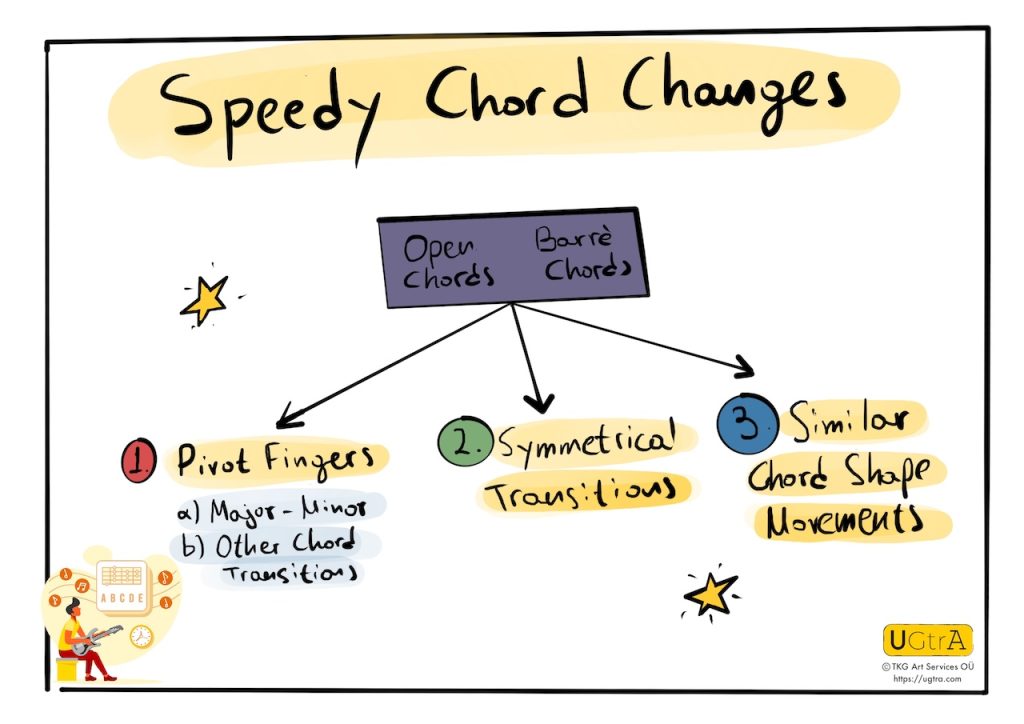[This is an excerpt from my Speedy Chord Changes Course, which is available exclusively as a bonus with the Rhythm Laced Column Course. It might be edited for the purpose of this article.]
Learning to change guitar chords quickly and smoothly is a must-have skill for any guitarist, whether you are a beginner or an experienced guitar player.
Chords are harmonic blocks (see UGtrA step 3: Harmonic blocks), similar to the building blocks in construction.
Imagine a wall of uneven bricks with gaps and holes in between them. This is how poor rhythm guitar playing can sound.
Smooth transitions between guitar chords can make your playing sound more professional and cohesive, and it is essential for maintaining a steady rhythm and flow in your music.
In this article, we’ll explore a strategic approach to analyzing chord progressions and design specific exercises using basic chords to build muscle memory, eliminate bad habits, and skyrocket your progress.
So, the first thing you should do when you are about to play a new chord progression (song), is to analyze step-by-step each chord transition.
You’ll fall into one of the following cases:
1. Transitions using Pivot Fingers (Common Chord Tones)
2. Symmetrical Chord Shapes Movement
3. Similar Chord Shape Movement
4. Unrelated Chord Shape Movement
Let’s get deeper into each one and see how to approach them:
1.Transitions using Pivot Fingers (Common Chord Tones)
The first type of chord changing is the pivot fingers or common tones transition.
Common chord tones are the shared fretted notes (finger positions) between the chords you are transitioning between.
By keeping the same fingers and moving only the ones that need to move, you achieve two things:
- a) You maintain the sound of the common chord tones while switching from one chord to the other, achieving a smooth harmonic transition. (This is also a harmony rule in composition—keeping the common tone from one chord to the next for good voice leading.)
- b) You move only the fingers that are needed, limiting unnecessary movements and hand tension. Thus, the transition can be achieved quickly and smoothly.
Let’s take an example: Transition from Am to C major chord.
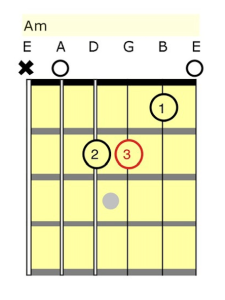

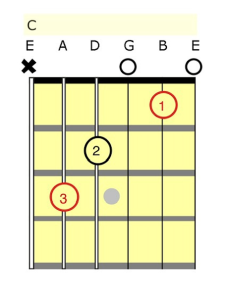

In the guitar diagrams above, you can clearly see that the two chords share the notes E (2nd fret, 5th string, and the open 1st string) and C (1st fret, 2nd string).
By keeping these common chord tones using the 2nd and 1st fingers and moving only the 3rd finger from the note A (2nd fret, 3rd string) to C (3rd fret, 5th string), we achieve all the benefits described above.
2. Symmetrical Chord Shapes Movement
There are cases where two consecutive chord shapes are almost identical, requiring symmetrical finger movements. There are two possibilities:
a) Moving Vertically
In this situation, all we have to do is move our fingers as a block one set of strings up or down. For example, let’s transition from E to Am chord.
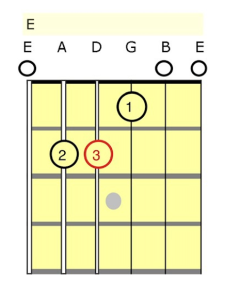



Notice how similar the shapes are. It’s actually the same chord shape on a different set of strings.
By moving your fingers as a block, you can achieve a smoother chord change, as you don’t have to focus on each finger individually.
b) Moving Horizontally
There are identical chord shapes that need to move horizontally.
For example, the transition from Am to Bbm.
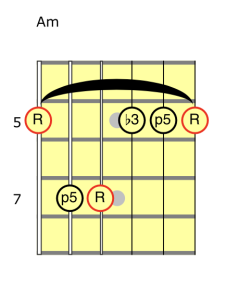

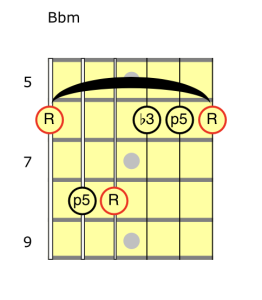

Notice that these two chord shapes are exactly the same but in different fretboard positions. The Am starts on the 5th fret, while the Bbm is on the 6th fret.
3. Similar Chord Shape Movement
In this category, we have guitar chords whose shapes are almost the same. This allows us to move as many fingers as possible, as a block to a different set of strings or horizontally, focusing more on the finger(s) that make the difference.
For example, Am to Dm.


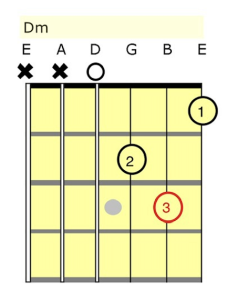

Notice how these chord shapes are so similar. We could move them as a block except for the third finger, which needs to move one fret further to the 3rd one on the 2nd string.
4. Unrelated Chord Shape Movement
There are, of course, cases where two consecutive chords have no similarities at all. These cases should be practiced individually to improve overall finger dexterity.
For example, C to D major chord.


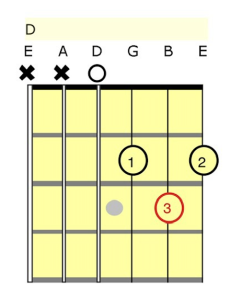

Additional Tips for Effective Practice
To maximize the effectiveness of your practice sessions, keep the following tips in mind:
1. Start Slowly: Begin practicing chord transitions at a slow tempo, using one chord strum to ensure accuracy and proper finger placement. Gradually increase your speed as you become more comfortable with the transitions.
2. Use a Metronome: It is possible to start by not using a metronome to develop basic dexterity. But practicing with it will help you develop a sense of timing and steady rhythm. Start at a slow tempo and gradually increase the speed as you improve.
3. Focus on Accuracy: Prioritize accuracy over speed. It’s better to play slowly and accurately than to rush and make mistakes. As you become more accurate, you can gradually increase speed while ensuring a professional sound at all tempos.
4. Practice Consistently: Consistency is key to developing any skill. Organize your guitar practice schedule aiming to practice chord transitions for at least 15-20 minutes each day.
5. Record Yourself: Recording your practice sessions can help you identify areas for improvement and track your progress over time. Don’t get fancy—just put your phone and take a quick video. It will work.
6. Stay Relaxed: Tension in your hands and fingers can hinder your ability to move your fingers with accuracy and speed. When learning something new on the guitar, your fingers may seem stiff, and tension can be unavoidable. This is why we practice at a slow, comfortable speed to limit this situation. [You see how all the steps work together and nothing is said without a purpose]
Conclusion
Mastering quick chord changes is an essential skill for any guitarist.
By focusing on finding commonalities between adjacent chord shapes and making use of pivot fingers, you can improve your chord transitions and elevate your playing.
Practice regularly, start slowly, and prioritize accuracy to develop muscle memory and build confidence in your playing.
Remember, the journey to becoming a proficient guitarist is a gradual process. Be patient with yourself, and enjoy the process of learning and improving.
With dedication and consistent practice, you will be able to change chords quickly and smoothly, enhancing your overall musical performance.
However, there’s a common trap that many beginner and intermediate guitarists fall into—wasting countless hours on practice with little progress…
The culprit is NOISE.
The internet is full of noise—random, inaccurate, and unstructured material is everywhere.
It’s easy to get lost, stuck, and see little progress…
That’s why I’ve created a comprehensive bundle of carefully designed courses to help you master open chords and achieve quick, smooth chord changes once and for all!
Click the button below to learn more about the Mastering Open (Cowboy) Chords & Speedy Chord Changes courses!
